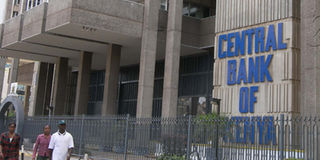Borrowers to pay more as rates shoot up

The Central Bank of Kenya. Photo/FILE
High interest rates being stimulated by the Central Bank of Kenya (CBK) will have far-reaching effects on banks and borrowers.
The impact of the upward review of the Central Bank Rate (CBR), the signal rate at which the regulator lends to commercial banks, will be felt more by those servicing loans and mortgages with flexible interest rates.
By raising the CBR from 6.25 per cent to 8 per cent, Central Bank has set the ground for interest rates to rise and analysts are warning that this will squeeze already stretched borrowers and lead to massive defaults on loan repayments.
This would mean increased under-performing loans for banks, which is likely to eat into their profits and slow the bullish run over the past two
years that has been rewarded with record earnings.
Defaults are an indication that businesses are either bleeding or stagnant and often lead to auctions as banks seek to recover their money.
CBK on Wednesday raised the rate at which it lends money to commercial banks in an effort to slow down inflation and stabilise the shilling, which
has been under pressure from speculative banks and forex dealers.
CBK to intervene
The local unit touched an all-time low of 91 to the dollar, forcing CBK to intervene as dollar demand grew because of increased imports of maize
and fuel.
High interest rates will certainly reduce the appetite for personal loans, cut consumption spending and, hopefully, slow inflation, which hit 14.49 in
June driven by rising food and oil prices.
At an average of 13.5 per cent, the current interest rate is still too high by international standards.
This is the strongest signal yet from CBK to commercial banks that it wants lending rates to start moving upwards. Analysts warn it will widen the
interest spread — the difference between deposit and lending rates — which remains a major concern.
Two banks have already raised the cost of borrowing in line with the rising benchmark rate. Commercial Bank of Africa has raised interest on loans
issued in Kenya shilling from 13 to 14 per cent, while I&M Bank will raise theirs by two percentage points to 15 per cent.
“We expect this most recent policy measure to prompt several other commercial banks to follow suit and raise their respective lending rates,” says
Ms Yvonne Mhango, an economist at Renaissance Capital.
Mr Jackson Kitili, director of banking services at CBK, said the move was also meant to stop banks from borrowing from it at 6.25 per cent and
then making huge profits by lending the same money to the government through Treasury bills at 9 per cent.
The International Monetary Fund (IMF) is said to be putting pressure on the government to increase interest rates to contain inflation. Most of the
credit, especially for house buyers, has led to an imbalance between deposits and loans.
“Given that the mid-tier banks reduced their lending rates the most during the Central Bank’s CBR cutting cycle that ended in January 2011, we are
not surprised they have been the first banks to start hiking their rates,” Ms Mhango says.




